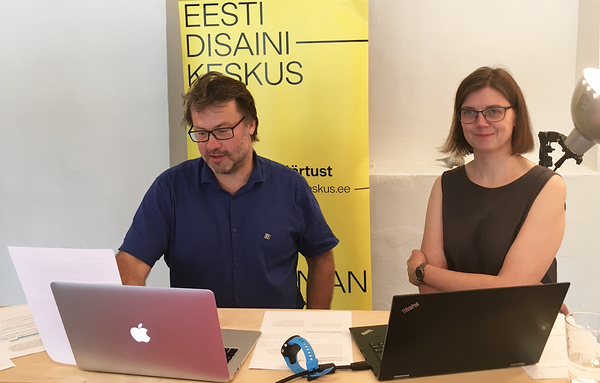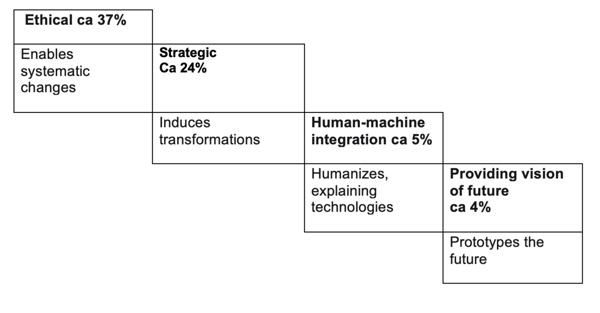Open and vague. Mapping the emerging design practices
A new research for mapping the emerging design practices in Estonia, ordered by the Estonian Design Centre, became ready for publishing in 2020.
This was the first initiative in comprehensive research of the field, undertaken by the Estonian Design Centre, in order to establish better overview of the field of design, and to enable comparison on global level. The research of emerging design practices was conducted by Ruth-Helene Melioranski and Martin Pärn with financial support from the Ministry of Culture.
Photo: Martin Pärn and Ruth-Helene Melioranski introducing the research results in 2020.
Design in the changing world
The world is undergoing major changes. Fast changes are taking place in social sphere as well as in technological and environmental processes, and this has brought changes also into design. Changing design field is much discussed in global context. Design is becoming increasingly multi-faceted, its field of activity is broadening vigorously and changing internally, causing also turbidity of the identity of the speciality and complexity of professional self-identification.
New roles of design
A recent research, the initial results of which were introduced in the Service Design Global Conference (2020), was the global research conducted by SDD Milan, concentrating on transformation of design, various emerging design profiles and potential for implementing design in different fields, including expansion of the skills of a designer and mapping of new perspectives and future potential.
According to this research, the
field of design can be divided as follows:
* The rest (ca 1/3) is traditional design.
Estonian design practices are also changing
Estonian society has also undergone profound transformation in recent decades. When starting the research, we were interested, how Estonian design and designers react to and accept the changes taking place in the society, and if the processes occurring in Estonian design can be compared to global processes. This time, our research did not cover the entire field of activity of design practices with its multitude, but was concentrated on the search for new trends and changes in the current design practice of Estonia.
We set the target to map new phenomena, to concentrate on the changes in the nature and comprehension of design, designer and designing. Contemporary Estonian design is versatile. It provides a stage for major design offices providing complex services, as well as teams of one or two persons with narrow specialization. Our research was focused on the providers of design service and their professional practice. The research did not cover undertaking designers manufacturing their own products, or processes in design education.
Which are the main conclusions of the research of design practices?
- Design is changing. Design is immaterializing, becoming „free from material”. This also means that design is no longer guided by issues and aspects based on material, but by relations and their networks. Design in its new form of appearance is organizer of relations or modifier of various lines of force.
- The task of design is changing. The object is no more the creation of objects, but rather talking about background and objectives – why we are doing something, and in which context. The role of design orders and tasks set to design has changed, creative intervention is used for defining the task itself (the set objective) as well as the benefit intended to be offered to the users and other parties as the end solution. Innovative design service is coupling with the design of strategic tasks of an organization, strongly involved in defining, initiating, effecting and realizing progressive changes, thus helping to create essentially new values.
- Design is becoming more research based. Former significant concentration on practice in Estonian design has started to change. The central role of design research is to collect input, to find new directions for shaping the entire following design process and its result. Design research is focused on searching and producing options for changing the situation.
- The field of design is becoming more democratic, and the circle of participants in the design process is substantially broadening. Involvement of experts of different specialities as well as later users of design has become common. Designer is no longer the only designer, but design skill is spreading to other fields, while also becoming a basic skill for everyone.
- The role of a designer is changing. Designer is turning from the creator of strictly defined „object” into the initiator of design process, leader and controller of discussion, executive manager and supervisor of cooperative creation. Search, description and testing of potential solutions or options for new problem situations has taken central position in the operation of a designer. Style and form will be created in the last stages of the process, and these are rather forms and shapes of expression of the activity than aspects activating the design.
Which are new profiles of a designer?
The emerged new designer profiles supplement the former job descriptions of a designer, and can connect horizontally various traditional fields of design.
Three new designer profiles:
- Designer as a strategist, focusing on the development of the essential strategy for changes. Designers are turning from providers of purely creative service to partners of organizations on operative level in creating strategic vision and making decisions.
- Designer as a leader. In the role of design manager, the designer shall handle two fields: management and administration of the process from one side, and its supervision as the initiator from the other.
- Designer as a researcher. Here, the designer undertakes the role of developer and performer of research plan. This role requires the skill of collecting information, noticing the aspects not noticed before, and based on that, defining the future.
What changes are taking place in the skills expected from a designer?
With changes in design, the internal professional self-development of a designer has become essential. In addition to the traditional professional skills (mastering technologies, creating form and telling a narrative), a contemporary designer shall be able to:
- Work with people and organizations;
- Understand major systems;
- Describe systems, ensuring comprehension of the options for inducing changes.
Changes take time.
It can be said that although the Estonian design scene is changing, the new practices have rather searching, asking and testing character. The broader discourse of design is still functioning with former patterns, and new practices have not yet taken roots. While design has moved from object to process, relations and experiences, the objects and aesthetics are still prevalent when thinking and speaking of design.
Compared to global practices, we can see professionally uncovered or poorly covered topics, so-called „white areas” in Estonia. An example of this is speculative or future-oriented design, testing critical scenarios and visions of future. Also the issues related to sustainability (although slightly already handled) need much deeper coverage.
How to speed up changes?
In Estonia, design is almost entirely regulated by market mechanisms, the field is developing rather based on orders, and therefore expermental and innovative practices change the design market very slowly. There is a need to develop and guide new design culture, to launch programmes and experiments. This in turn requires the needed support mechanisms.
Models are accompanied by specific vocabulary. Contemporary framework of terms in Estonian language is currently lacking, English terminology and loanwords are frequently used, and the need for local terminology is high. Changes in the skills expected from a designer presume revision of the concept and options of lifelong learning in the field of design, and finding possibilities for its support and development.
Summary of the research by Tiia Vihand

